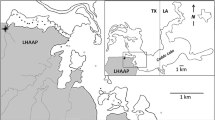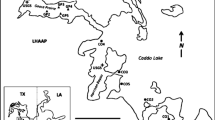Abstract
Sediment toxicity and benthic macroinvertebrate community structure were measured as one component of a study cohceived to determine the distribution and effect of sediment contamination in tidal freshwater portions of the Potomac and Anacostia rivers in the Washington, D.C., area. Samples were collected at 15 sites. Analyses included a partial life cycle (28 d) whole sediment test using the amphipod Hyalella azteca (Talitridae) and an assessment of benthic community structure. Survival and growth (as estimated by amphipod length) were experimental endopoints for the toxicity test. Significant mortality was observed in 5 of 10 sites in the lower Anacostia River basin and at the main channel Potomac River site. Sublethal toxicity, as measured by inhibition of amphipod growth, was not observed. Toxicity test results were in general agreement with synoptically measured sediment contaminant concentrations. Porewater total ammonia (NH3+NH4 +) appears to be responsible for the toxicity of sediments from the Potomac River, while correlation analysis and simultaneously extracted metals: acid volatile sulfide (SEM∶AVS) results suggest that the toxicity associated with Anacostia River sediments was due to organic compounds. Twenty-eight macroinvertebrate taxa were identified among all sites, with richness varying from 5 to 17 taxa per site. Groups of benthic assemblages identified by group-average cluster analysis exhibited variable agreement with sediment chemical and sediment toxicity results. Integration of toxicological, chemical, and ecological components suggests that adverse environmental effects manifest in the lower Anacostia River benthos result from chemical contamination of sediment.
Similar content being viewed by others
Literature Cited
American Society for Testing and Materials. 1991a. Standard guide for conducting toxicity tests with freshwater invertebrates, p. E1383:1085–1104. In S. R. Canning, P. C. Fazio, D. Fisher, E. L. Gutman, C. T. Hsia, S. L. Kauffman, J. Kramer, M. Lane, C. M. Leinweber, and P. A. McGee (eds.), Annual Book of ASTM Standards, Water and Environmental Technology. Vol. 11.04. American Society for Testing and Materials, Philadelphia.
American Society for Testing and Materials. 1991b. Standard guide for conducting 10-day static sediment toxicity tests with marine and estuarine amphipods. p. E1367:1052–1075. In S. R. Canning, P. C. Fazio, D. Fisher, E. L. Gutman, C. T. Hsia, S. L. Kauffman, J. Kramer, M. Lane, C. M. Leinweber, and P. A. McGee (eds.), Annual Book of ASTM Standards, Water and Environmental Technology. Vol. 11.04. American Society for Testing and Materials, Philadelphia.
Ankley, G. T., A. Katko, and J. W. Arthur. 1990. Identification of ammonia as an important sediment-associated toxicant in the Lower Fox River and Green Bay, Wisconsin. Environmental Toxicology and Chemistry 9:313–322.
Burton, G. A. 1991. Assessing the toxicity of freshwater sediments. Environmental Toxicology and Chemistry 10:1585–1627.
Chapman, P. M. 1987. Marine sediment toxicity tests, p. 391–402. In J. J. Lichtenberg, F. A. Winter, C. I. Weber, and L. Fradkin (eds.), Chemical and Biological Characterization of Sludges, Sediments, Dredge Spoils, and Drilling Muds. ASTM STP 976, American Society for Testing and Materials, Philadelphia.
Chapman, P. M. 1989. Current approaches to developing sediment quality criteria. Environmental Toxicology and Chemistry 8: 589–599.
Chapman, P. M., R. N. Dexter, R. M. Kocan, and E. R. Long. 1985. An overview of biological effects testing in Puget Sound, Washington: Methods, results, and implications, p. 344–363. In R. D. Cardwell, R. Purdy, and R. C. Bahner (eds.), Aquatic Toxicology and Hazard Assessment: Seventh Symposium. ASTM STP 854, American Society for Testing and Materials, Philadelphia.
Chapman, P. M., R. N. Dexter, and E. R. Long. 1987. Synoptic measures of sediment contamination, toxicity, and infaunal community structure (the Sediment Quality Triad) in San Francisco Bay. Marine Ecology Progress Series 37:75–96.
Charman, P. M., E. A. Power, R. N. Dexter, and H. B. Andersen. 1991. Evaluation of effects associated with an oil platform, using the sediment quality triad. Environmental Toxicology and Chemistry 10:407–424.
Collyard, S. A., R. A. Hoke, and J. S. Denny. 1991. Optimizing reproduction in cultures of Hyalella azteca. For use in sediment toxicity assessments. Society of Environmental Toxicology and Chemistry, Twelfth Annual Meeting, November 3–7, Seattle, Washington.
DiToro, D. M., C. S. Zarba, D. J. Hansen, W. J. Berry, R. C. Swartz, C. E. Cowan, S. P. Pavlou, H. E. Allen, N. A. Thomas, and P. R. Paquin. 1991. Technical basis for establishing sediment quality criteria for nonionic organic chemicals by using equilibrium partitioning. Environmental Toxicology and Chemistry 10:1541–1583.
DiToro, D. M., J. D. Mahony, D. J. Hansen, K. J. Scott, M. B. Hicks, S. M. Mayr, and M. S. Redmond. 1990. Toxicity of cadmium in sediments: The role of acid volatile sulfide. Environmental Toxicology and Chemistry 9:1487–1502.
Edmonson, S. A. 1988. 1987 macroinvertebrate census of the District of Columbia. Department of Consumer and Regulatory Affairs, Washington, D.C., 52 p.
Hart, C. W. and S. L. H. Fuller. 1974. Pollution Ecology of Freshwater Invertebrates. Academic Press, London. 389 p.
Holiand, A. F., A. T. Shaughnessy, L. C. Scott, V. A. Dickens, J. A. Ransinghe, and J. K. Summers. 1988. Progress report: Long-term benthic monitoring and assessment program for the Maryland portion of Chesapeake Bay (July 1986–October 1987). PPRP-LTB/EST-88-1. VERSAR, Inc., Columbia, Maryland. 304 p. +appendices.
Ingersoll, C. G. and M. K. Nelson. 1990. Testing sediment toxicity with Hyalella azteca (Amphipoda) and Chironomus riparius (Diptera), p. 93–109. In W. G. Landis and W. H. van der Schalie (eds.), Aquatic Toxicology and Risk Assessment: Thirteenth Symposium. STP 1096. American Society for Testing and Materials, Philadelphia.
Johns, D. M., T. C. Ginn, and R. Ciammaichella. 1991. Neanthes long-term exposure experiment: Further evaluation of the relationship between juvenile growth and reproductive success. EPA 910/9-91-026. Technical Report for United States Environmental Protection Agency, Region 10, Seattle, Washington, 19 p.
Landrum, P. F. and J. A. Robbins. 1990. Bioavailability of sediment-associated contaminants to benthic invertebrates, p. 237–264. In R. Baudo, J. P. Giesy, and H. Muntau (eds.), Sediments: Chemistry and Toxicity of In-Place Pollutants. Lewis Publishers, Inc., Ann Arbor, Michigan.
LaPoint, T. W. and J. F. Fairchild. 1992. Evaluation of sediment contaminant toxicity: The use of freshwater community structure, p. 87–110. In G. A. Burton, Jr. (ed.), Sediment Toxicity Assessment. Lewis Publishers, Inc., Ann Arbor, Michigan.
Liddicoat, M. I., S. Tibbitts, and E. I. Butler. 1975. The determination of ammonia in seawater. Limnology and Oceanography 20:131–132.
Long, E. R. and P. M. Chapman. 1985. A sediment quality triad: Measures of sediment contamination, toxicity, and infaunal community composition in Puget Sound. Marine Pollution Bulletin. 16:405–415.
McGee, B. L., C. E. Schlekat, and E. Reinharz. 1993. Assessing sublethal levels of sediment contamination using the estuarine amphipod Leptocheirus plumulosus. Environmental Toxicology and Chemistry 12:577–587.
Nemec, A. F. L., and R. O. Brinkhurst. 1988. Using the bootstrap to assess statistical significance in the cluster analysis of species abundance data. Canadian Journal of Fisheries and Aquatic Science 45:965–970.
Phelps, H. L. 1990. Anacostia River sediment toxicity. Localization and characterization using a Corbicula larva bioassay. University of the District of Columbia, Water Resource Research Center, Washington, D.C., Publication No. 88-06. 33 p.
Rice, W. R. 1989. Analyzing tables of statistical tests. Evolution 43:223–245.
SAS Institute. 1985. SAS User's Guide: Statistics, Version 5 Edition. SAS Institute, Cary, North Carolina. 956 p.
Schubauer-Berigan, M. K. and G. T. Ankley. 1991. The contribution of ammonia, metals, and nonpolar organic compounds to the toxicity of sediment interstitial water from an Illinois River tributary. Environmental Toxicology and Chemistry 10:925–939.
Shackelford, B. 1988. Rapid bioassessment of lotic macroinvertebrate communities: Biocriteria development. Biomonitoring Section, Arkansas Department of Pollution Control and Ecology. Little Rock, Arkansas. 45 p.
Shepard, F. P. 1954. Nomenclature based on sand-silt-clay rations. Journal of Sedimentary Petrology 24:151–158.
Solorzano, L. 1969. Determination of ammonia in natural waters by the phenylhypochlorite method. Limnology and Oceanography 14:799–801.
Stebbing, A. R. D. 1981. Hormesis—Stimulation of colony growth in Campinularia flexuosa (Hydrozoa) by copper, cadmium, and other toxicants. Aquatic Toxicology 1:227–238.
United States Environmental Protection Agency. 1990. Macroinvertebrate field and laboratory methods for evaluating the biological integrity of surface waters. Report No. 600/4-90/030. Office of Research and Development, United States Environmental protection Agency. Cincinnati, Ohio. 270 p.
United States Geological Survey. 1985. Measurement and use of diversity indices for biological samples in water quality programs. Technical Memorandum. No. 85.10. United States Geological Survey. Reston, Virginia. 10 p.
Velinsky, D. J., C. Haywood, T. L. Wade, and E. Reinharz. 1992. Sediment contamination studies of the Potomac and Anacostia rivers around the District of Columbia. Interstate Commission on the Potomac River Basin. Rockville, Maryland. Report. No. 92-2. 148 p.
Velinsky, D. J., T. L. Wade, C. E. Schlekat, B. L. McGee, and B. J. Presley. 1994. Tidal River Sediments in the Washington, D.C. Area. I. Distribution and Sources of Trace Metals. Estuaries 17:305–320.
Wade, T. L., D. J. Velinsky, E. Reinharz, and C. E. Schlekat. 1994. Tidal River Sediments in the Washington, D.C. Area. II. Distribution and Sources of Organic Contaminants. Estuaries 17:321–333.
Wilkinson, L. 1989. SYSTAT: The System for Statistics. Systat, Inc., Evanston, Illinois, 677 p.
Author information
Authors and Affiliations
Rights and permissions
About this article
Cite this article
Schlekat, C.E., McGee, B.L., Reinharz, E. et al. Tidal river sediments in the Washington, D.C. area. III. Biological effects associated with sediment contamination. Estuaries 17, 334–344 (1994). https://doi.org/10.2307/1352667
Received:
Accepted:
Issue Date:
DOI: https://doi.org/10.2307/1352667




